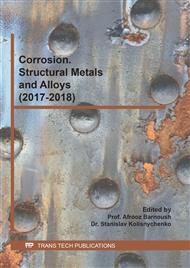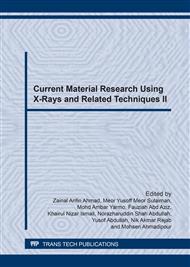[1]
K.L. Lin, T.P. Liu, The electrochemical corrosion behaviour of Pb-free Al-Zn-Sn solders in NaCl solution, Mater. Chem. Phys. 56 (1998) 171-176.
DOI: 10.1016/s0254-0584(98)00171-0
Google Scholar
[2]
G. Zeng, S. Xue, L. Zhang, L. Gao, Recent advances on Sn–Cu solders with alloying elements: review, J. Mater. Sci-Mater El. 22 (2011) 565-578.
DOI: 10.1007/s10854-011-0291-3
Google Scholar
[3]
M. Abtew, G. Selvaduray, Lead-free solders in microelectronics, Materials Science and Engineering: R: Reports, 27 (2000) 95-141.
DOI: 10.1016/s0927-796x(00)00010-3
Google Scholar
[4]
M. Liu, W. Yang, Y. Ma, C. Tang, H. Tang, Y. Zhan, The electrochemical corrosion behavior of Pb–free Sn–8. 5 Zn–XCr solders in 3. 5 wt% NaCl solution, Mater. Chem. Phys. 168 (2015) 27-34.
DOI: 10.1016/j.matchemphys.2015.10.003
Google Scholar
[5]
M. Islam, Y. Chan, M. Rizvi, W. Jillek, Investigations of interfacial reactions of Sn–Zn based and Sn–Ag–Cu lead-free solder alloys as replacement for Sn–Pb solder, J. Alloy. Compd. 400 (2005) 136-144.
DOI: 10.1016/j.jallcom.2005.03.053
Google Scholar
[6]
S.K. Das, A. Sharif, Y.C. Chan, N.B. Wong, W. Yung, Influence of small amount of Al and Cu on the microstructure, microhardness and tensile properties of Sn–9Zn binary eutectic solder alloy, J. Alloy. Compd. 481 (2009) 167-172.
DOI: 10.1016/j.jallcom.2009.03.017
Google Scholar
[7]
D. Li, P.P. Conway, C. Liu, Corrosion characterization of tin–lead and lead free solders in 3. 5 wt. % NaCl solution, Corros. Sci. 50 (2008) 995-1004.
DOI: 10.1016/j.corsci.2007.11.025
Google Scholar
[8]
M.F.M. Nazeri, A.B. Ismail, A.A. Mohamad, Effect of polarizations on Sn–Zn solders alloys in alkaline electrolyte, J. Alloy. Compd. 606 (2014) 278-287.
DOI: 10.1016/j.jallcom.2014.04.034
Google Scholar
[9]
M. Mori, K. Miura, T. Sasaki, T. Ohtsuka, Corrosion of tin alloys in sulfuric and nitric acids, Corros. Sci. 44 (2002) 887-898.
DOI: 10.1016/s0010-938x(01)00094-4
Google Scholar
[10]
M.F.M. Nazeri, A.A. Mohamad, Corrosion measurement of Sn–Zn lead-free solders in 6M KOH solution, Measurement, 47 (2014) 820-826.
DOI: 10.1016/j.measurement.2013.10.002
Google Scholar
[11]
M.F.M. Nazeri, A.A. Mohamad, Effect of exposure to alkaline solution on Sn–9Zn solder joints, J. Mater. Process. Tech. 219 (2015) 164-172.
DOI: 10.1016/j.jmatprotec.2014.12.018
Google Scholar
[12]
J.C. Liu, G. Zhang, S. Nagao, J.T. Jiu, M. Nogi, T. Sugahara, J.S. Ma, K. Suganuma, Metastable pitting and its correlation with electronic properties of passive films on Sn–xZn solder alloys, Corros. Sci. 99 (2015) 154-163.
DOI: 10.1016/j.corsci.2015.06.036
Google Scholar
[13]
L. Vrbka, P. Jungwirth, Counter-Ion Effects and Interfacial Properties of Aqueous Tetrabutyl Ammonium Halide Solutions, Aust. J. Chem. 57(12) (2004) 1211–1217.
DOI: 10.1071/ch04125
Google Scholar
[14]
S.S.A. Rehim, S.M. Sayyah, M.M. El Deeb, Corrosion of tin in citric acid solution and the effect of some inorganic anions, Mater. Chem. Phys. 80 (2003) 696-703.
DOI: 10.1016/s0254-0584(03)00128-7
Google Scholar
[15]
M.F.M. Nazeri, A. A. Mohamad, Corrosion resistance of ternary Sn-9Zn-xIn solder joint in alkaline solution, J. Alloy. Compd. 661 (2016) 516-525.
DOI: 10.1016/j.jallcom.2015.11.184
Google Scholar
[16]
M.N. Mohamed, N.A. Aziz, A.A. Mohamad, M.F.M. Nazeri, Polarization Study of Sn-9Zn and Sn-37Pb Solders in Hydrochloric Acid Solution, Electroactive Materials, 3 (2015) 28-32.
Google Scholar



